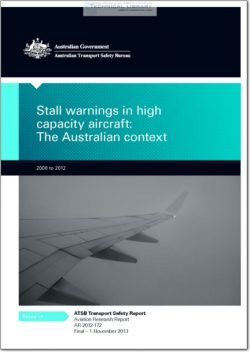ATSB-AR-2012-172

- Version
- 183 Downloads
- 1.49 MB File Size
- 1 File Count
- August 9, 2016 Create Date
- August 9, 2016 Last Updated
Stall Warning in High Capacity Aircraft; The Australian Context

Stall warning events are an area of interest for high capacity airlines and aviation safety
investigators as they indicate that an aircraft was operating at the margins of safe flight.
Inappropriate management of stall warnings by flight crew increases the risk of a stall, and a
resulting temporary (but normally recoverable) loss of aircraft control.
Stall warnings are a warning only, and are a defence provided to ensure flight crew take corrective
action to prevent a stall from developing. They have a low risk in themselves, but indicate a
possibility for a more serious outcome because the aircraft is flying at a speed that is lower than it
should be for the flight condition and configuration it is in, or the wing has a higher angle of attack
than is suitable. Many stall warnings, such as those that occur in turbulence during cruise, are not
likely to indicate a loss of control will occur, and are low risk. Some stall warnings, such as those
that occur on final approach at a high angle of attack and at a low airspeed, are high risk because
of insufficient altitude to recover from a stall if one was to follow and the likelihood of a subsequent
terrain collision. In all instances, stall warnings should be treated as an approach to stall (even if
the warning may be spurious or low risk), and immediate action taken to reduce the angle of
attack.
A stall occurs when the smooth airflow over an aeroplane’s wing is disrupted, and it
loses lift rapidly. This causes the aircraft to descend. This is caused when the wing
exceeds its critical angle of attack (the angle of the wing relative to the direction of
the airflow). This can occur at any airspeed, at any attitude, and at any power setting.
Aviation safety incidents and accidents in Australia, or involving Australian-registered aircraft
operating overseas, are reportable to the Australian Transport Safety Bureau (ATSB) under the
provisions of the Transport Safety Investigation Regulations 2003. Most accidents and incidents
that pose a serious risk to aviation safety are investigated. All reported occurrences, however, are
used to help the ATSB monitor the health of aviation across Australia and assist in the
identification of emerging safety issues before they manifest into accidents. Furthermore, by
publishing such analysis, it is hoped that the wider aviation industry will be able to learn from the
experience of others.
| File | Action |
|---|---|
| ATSB-AR-2012-172 Stall Warning in High Capacity Aircraft; The Australian Context.pdf | Download |

Comment On This Post